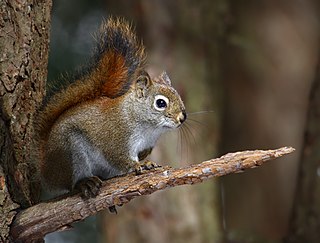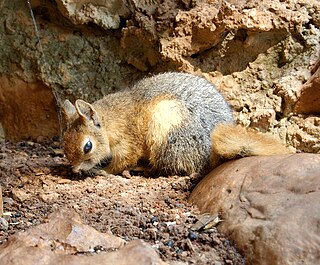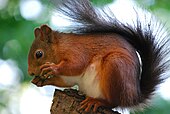
Sciurinae is a subfamily of squirrels, uniting the flying squirrels with certain related tree squirrels. Older sources place the flying squirrels in a separate subfamily (Pteromyinae) and unite all remaining sciurids into the subfamily Sciurinae, but this has been strongly refuted by genetic studies.

The western gray squirrel is a tree squirrel found along the western coast of the United States and Mexico. In some places, this species has also been known as the silver-gray squirrel, the California gray squirrel, the Oregon gray squirrel, the Columbian gray squirrel and the banner-tail. There are three geographical subspecies: Sciurus griseus griseus ; S. g. nigripes ; and S. g. anthonyi.

The fox squirrel, also known as the eastern fox squirrel or Bryant's fox squirrel, is the largest species of tree squirrel native to North America. Despite the differences in size and coloration, it is sometimes mistaken for American red squirrels or eastern gray squirrels in areas where the species co-exist.

The American red squirrel is one of three species of tree squirrels currently classified in the genus Tamiasciurus, known as the pine squirrels. The American red squirrel is variously known as the pine squirrel or piney squirrel, North American red squirrel, chickaree, boomer, or simply red squirrel. The squirrel is a small, 200–250 g (7.1–8.8 oz), diurnal mammal that defends a year-round exclusive territory. It feeds primarily on the seeds of conifer cones, and is widely distributed across much of the United States and Canada wherever conifers are common, except in the southwestern United States, where it is replaced by the formerly conspecific southwestern red squirrel, and along the Pacific coast of the United States, where its cousin the Douglas squirrel is found instead.

The genus Sciurus contains most of the common, bushy-tailed squirrels in North America, Europe, temperate Asia, Central America and South America.

Abert's squirrel or the tassel-eared squirrel is a tree squirrel in the genus Sciurus native to the southern Rocky Mountains from the United States to the northern Sierra Madre Occidental of Mexico, with concentrations found in Arizona, New Mexico, and southwestern Colorado. It is closely associated with, and largely confined to, mature ponderosa pine forests. It is named in honor of the American naturalist John James Abert; nine subspecies are recognised. It is recognizable by its tufted ears, gray color, pale underparts and rufous patch on the lower back. The squirrel feeds on the seeds and cones of the Mexican pinyon and the ponderosa pine when they are available, but will also take fungi, buds, bark, and carrion. Breeding normally occurs in summer, with a spherical nest being built high in the canopy.

The Bolivian squirrel is a tree squirrel that is endemic to South America. Little is known of the species, which may represent a species complex.

The Amazon dwarf squirrel is a chipmunk-sized tree squirrel native to South America.

The Mexican gray squirrel is a tree squirrel in the genus Sciurus native to Guatemala and eastern and southern Mexico. It has been introduced to the Florida Keys.

The Caucasian squirrel or Persian squirrel, is a tree squirrel in the genus Sciurus found in temperate broadleaf and mixed forests in south-western Asia.

The Arizona gray squirrel is a tree squirrel, in the genus Sciurus, endemic to the canyons and valleys surrounded by deciduous and mixed forests in eastern Arizona and northern Mexico.

Collie's squirrel is a tree squirrel in the genus Sciurus endemic to Mexico.

Deppe's squirrel is a species of tree squirrel in the genus Sciurus native to Belize, Costa Rica, El Salvador, Guatemala, Honduras, Mexico, and Nicaragua.

The fiery squirrel is a rodent in the family Sciuridae. The taxon is endemic to the area south of the Orinoco River in the state of Bolívar, Venezuela.

Peters's squirrel is a tree squirrel in the genus Sciurus endemic to Mexico. It was first described by the German naturalist and explorer Wilhelm Peters in 1863. Three subspecies are recognised. It is a common species, and the IUCN has rated its conservation status as being of "least concern".
Sanborn's squirrel is or was a little known tree squirrel described in 1944 from the skin and skeleton of a single female specimen collected in Peru in 1941. Subsequently, over the proceeding years only a handful of either specimens were collected, or observations were recorded, in the regions of Madre de Dios and northern Puno in Peru, and Pando department in Bolivia. The 2019 IUCN assessment describes it as endemic to Peru. In 2015 this taxon was synonymised with Notosciurus pucheranii ssp. boliviensis. Its habitat is tropical dry broadleaf forests at elevations up to 570 m. It is considered possibly rare and potentially vulnerable to deforestation, but its population trend is not established.

The variegated squirrel is a tree squirrel in the genus Sciurus found in Costa Rica, El Salvador, Guatemala, Honduras, southern Mexico, Nicaragua, and Panama. Fifteen subspecies are recognised. It is a common squirrel and the International Union for Conservation of Nature has rated it a "least-concern species". Variegated squirrels kept as pets in Germany have been implicated in the transmission of a bornavirus to humans from which three people have died.

The Yucatan squirrel, originally named the Yucatan gray squirrel, also once named the Campeche squirrel, is a tree squirrel in the genus Sciurus found in the Yucatán Peninsula and adjacent areas. It is native to northern Belize, northeastern Guatemala, and southeast Mexico.

Mearns's squirrel is a subspecies of the Douglas squirrel endemic to Mexico. It is endangered and occurs in low densities, and is threatened by habitat loss. It is possibly also threatened by competition from the eastern gray squirrel, which was introduced to the range of Mearns's squirrel in 1946, but may not be present anymore. It is closely related to other subspecies of the Douglas squirrel, but far less is known about its behavior, which was first studied in detail in 2004. It is named for the 19th-century American naturalist Edgar Mearns.

John L. Koprowski, Dean and Professor, Haub School of Environment & Natural Resources, University of Wyoming, mammalogist, conservation biologist, and leading expert on the ecology and conservation of wildlife, especially squirrels, was born in 1961 in Lakewood, Ohio.
























